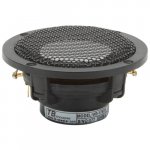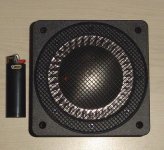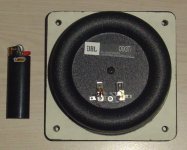Contrary to what seems intuitive, a given diameter dome will have worse dispersion at high frequencies than the same diameter cone, due to its convex shape vs the concave shape of a cone.92 dB at what frequency? Hardly 91 dB/W and at very narrow bandwidth.
Very strange dispersion that has.Beaming is much stronger than in ordinary 4,5" cone mid.

Only because dome tweeters are so small is this dispersion disadvantage mitigated, but make them as big as a midrange driver and the problem becomes apparent. Just one of the drawbacks of a dome midrange driver...
62 responses and nobody has answered the question.
A dome requires the voice coil diameter be the same as the diameter of the radiating surface. If you need a 4 inch unit for output, bandwidth and dispersion reasons, then you must have a 4 inch voice coil. Therefore a 4" gap motor structure.
Do the cost comparison between a 4" VC motor and a 3/4" VC motor. The 4" VC is forced by going the dome route but is typically not required for thermal power handling reasons.
Poor value, so limited market appeal.
David S.
A dome requires the voice coil diameter be the same as the diameter of the radiating surface. If you need a 4 inch unit for output, bandwidth and dispersion reasons, then you must have a 4 inch voice coil. Therefore a 4" gap motor structure.
Do the cost comparison between a 4" VC motor and a 3/4" VC motor. The 4" VC is forced by going the dome route but is typically not required for thermal power handling reasons.
Poor value, so limited market appeal.
David S.
sure Dave, but that begs the question as to why there were so many of them out and about in the 80s... the ratios of cost remain the same.
And you lose the cost of the basket, the front pole piece is still there, just a different shape... and of course the magnet is different, usually... the larger VC is more expensive.
_-_-bear
And you lose the cost of the basket, the front pole piece is still there, just a different shape... and of course the magnet is different, usually... the larger VC is more expensive.
_-_-bear
I remember a few more in the 80s, but not lots. I think the cost issue kept their popular sizes down to 1.5" to 2", which meant much less bandwidth than, say, a 5" cone mid. If you do a properly big one in the 3 to 4" range (like an ATC) then the magnet structure is the equal to a high end woofer structure.
Big magnet structures are expensive in every part: magnet ring, core pole and back plate and top plate.
Not saying the performance can't be great, just that it will cost you.
David S.
Big magnet structures are expensive in every part: magnet ring, core pole and back plate and top plate.
Not saying the performance can't be great, just that it will cost you.
David S.
Last edited:
It is obvious that small dome mid has lower value in general because it is not so versatile as cone driver with much bigger xmax. Cost matters much more for commercial manufacturers where about 10% of speaker's price can be used for drivers. Situation is not the same for "us", hobbyist. For me, driver is not so expensive even if it costs twice as much as its competitor if it's someway better. In commercial world, twice the price is usually total turnoff.
Clearly it is seen that dome mid is only large tweeter. You can not stretch them to produce male voices etc, it should be used with semi sized midwoofer when you don't want to stretch your tweeter to 1500 Hz and maybe when you want to use very small dome as supertweeter. Almost all 8" midwoofers should be crossed around 1500 Hz, so feels that dome mid might have their place for turning 8"+1" into 3-way 8"+dome mid+0,75". Much complex design (low value, not for commercial) but lot stress for tweeter and bandwidth spread for 3 units.
Clearly it is seen that dome mid is only large tweeter. You can not stretch them to produce male voices etc, it should be used with semi sized midwoofer when you don't want to stretch your tweeter to 1500 Hz and maybe when you want to use very small dome as supertweeter. Almost all 8" midwoofers should be crossed around 1500 Hz, so feels that dome mid might have their place for turning 8"+1" into 3-way 8"+dome mid+0,75". Much complex design (low value, not for commercial) but lot stress for tweeter and bandwidth spread for 3 units.
Last edited:
I think dome mids of the 80's were partly a response to the introduction of dome tweeters in the 70's - what works well for tweeters must work well when scaled up for midrange, right ? Well, no...
One major problem is that a soft dome mid is going to be non-piston over most if not all of its range as its simply too big and floppy for the frequencies involved. Mechanically what works at 1" doesn't scale up to 3-4".
If its operating in a non piston fashion that means bending waves, standing wave patterns and so on. If a bending wave originates from the ring at the edge it must travel towards the centre, but then what ?
There is nothing at the centre to absorb it, just a continuation of the dome, so the waves keep going and reflect off the opposite side like the ripples from a stone dropped in an enclosed pool.
You either put up with severe standing wave patterns which will make the response ragged and full or resonances, or you heavily damp the dome material to try to get the bending waves to mostly dissipate before they get to the middle, but then you sacrifice high frequency response, and turn it into a ring radiator where the middle is just a useless lump at high frequencies.
A dome driven at the edge is a fundamentally poor choice for a large wide band driver that of necessity would have to be operating in its breakup region, and there is no good way to terminate the standing waves that doesn't also result in killing the high frequency response, hence the poor top end response of a dome mid compared to a wide band cone driver.
On the other hand a cone driver is eminently more suitable for operating in its breakup region. It too will be in breakup at high frequencies but now the bending waves are originating from the centre, travelling towards the outside of the cone and (hopefully) being absorbed at the edge by the surround and/or damping treatment near the perimeter of the cone.
Properly designed, a cone driver can make an excellent bending wave transducer that will operate well past the point where it is no longer in piston operation. (In some drivers as much as 2 octaves)
At the bottom end a cone driver is much more rugged and better able to produce low frequencies without rocking motions, bending of the cone, and with greater x-max, so is clearly a better choice for the low frequency end of its range than a dome.
So the dome doesn't do low frequencies well, nor high frequencies. What does it do well ? Not much. At most its a narrow band transducer which is only suitable for a 4 way design or a very small 3 way. When you take into account the large complicated motor its no wonder they went away.
That's not to say a dome mid can't sound good, but if anything its going to be an uphill battle with dubious payoff.
I think Lynn Olson summed up the drawbacks of soft dome midranges very nicely in this article:
The Art of Speaker Design, Part II
One major problem is that a soft dome mid is going to be non-piston over most if not all of its range as its simply too big and floppy for the frequencies involved. Mechanically what works at 1" doesn't scale up to 3-4".
If its operating in a non piston fashion that means bending waves, standing wave patterns and so on. If a bending wave originates from the ring at the edge it must travel towards the centre, but then what ?
There is nothing at the centre to absorb it, just a continuation of the dome, so the waves keep going and reflect off the opposite side like the ripples from a stone dropped in an enclosed pool.
You either put up with severe standing wave patterns which will make the response ragged and full or resonances, or you heavily damp the dome material to try to get the bending waves to mostly dissipate before they get to the middle, but then you sacrifice high frequency response, and turn it into a ring radiator where the middle is just a useless lump at high frequencies.
A dome driven at the edge is a fundamentally poor choice for a large wide band driver that of necessity would have to be operating in its breakup region, and there is no good way to terminate the standing waves that doesn't also result in killing the high frequency response, hence the poor top end response of a dome mid compared to a wide band cone driver.
On the other hand a cone driver is eminently more suitable for operating in its breakup region. It too will be in breakup at high frequencies but now the bending waves are originating from the centre, travelling towards the outside of the cone and (hopefully) being absorbed at the edge by the surround and/or damping treatment near the perimeter of the cone.
Properly designed, a cone driver can make an excellent bending wave transducer that will operate well past the point where it is no longer in piston operation. (In some drivers as much as 2 octaves)
At the bottom end a cone driver is much more rugged and better able to produce low frequencies without rocking motions, bending of the cone, and with greater x-max, so is clearly a better choice for the low frequency end of its range than a dome.
So the dome doesn't do low frequencies well, nor high frequencies. What does it do well ? Not much. At most its a narrow band transducer which is only suitable for a 4 way design or a very small 3 way. When you take into account the large complicated motor its no wonder they went away.
That's not to say a dome mid can't sound good, but if anything its going to be an uphill battle with dubious payoff.
I think Lynn Olson summed up the drawbacks of soft dome midranges very nicely in this article:
The Art of Speaker Design, Part II
Last edited:
Between ?Would a flatcone be the best compromise?
So the dome doesn't do low frequencies well, nor high frequencies. What does it do well ? Not much. At most its a narrow band transducer which is only suitable for a 4 way design or a very small 3 way. When you take into account the large complicated motor its no wonder they went away.
Maybe it is because the midrange domes of my speaker are not soft (they are beryllium) but my ears tell me they do a splendid job in the 500 - 6000 Hz range, putting maybe not all but definitely most cone midranges in the shade.
No dispersion problems either.
And why not?
Ok, I know, some people will suggest they lack of "dynamic" (??? again a questionable term ???) and that they can oscillate because of the surround only suspension (no spider), or will invoke the breaking modes.
But, when I was using a Dynaudio D54 in complement of an Audax PR17TSM, or of a Supravox 215 RTF, it was always much better. And at these days, no EQ.
Actually I know people that use 2" open back compression drivers, so finally mid domes ( D54 is vented too) and they don't complain of a lack of clarity or "dynamic"..
Here a study of the ATC (featuring a double suspension).
I have a pair of 500 Hz tractrix horns from Bruce Edgar that are designed for the D54. I did a RTA on it in my living room and it was pretty flat from 500 Hz to 5kHz. I bought a pair of DE10/ME10 tweeter horns to go with them, but I'm still scratching my head about a bass unit.
Anyway, the D54 is a nice driver.
at what price?
Madisound wants ~100$ USD... too much for this project.
_-_-bear
Used D54's go for that on eBay.
The Dynaudio D52AF still holds the candle as the best upper midrange that I have ever heard.
I wouldnt use it below about 800 Hz though.
http://www.gattiweb.com/images/dynaudio/d52af_data2.pdf
I wouldnt use it below about 800 Hz though.
http://www.gattiweb.com/images/dynaudio/d52af_data2.pdf
The Dynaudio D52AF still holds the candle as the best upper midrange that I have ever heard.
I wouldnt use it below about 800 Hz though.
http://www.gattiweb.com/images/dynaudio/d52af_data2.pdf
For sure nice specs for a midrange.
Thanks WGA. Didn't know about the rocking issue. I'm no driver expert, but it does seem difficult to include a 2nd suspension in such a driver.Cannot implement a dual suspension (surround-spider) system easily that supports the larger excursions required while mitigating the modal rocking that can occur at lower frequencies. Competing cone driver of same performance quality typically cost less to make.
Regards,
WHG
Anyone have an opinion concerning the advantages or disadvantages of Advent's polypropylene "donut" midrange? It shared the so-called cone/dome shape the tweeter in the first Advents used for years and their first 3-way, the 6003, used it first. You can see them here (scroll down just past halfway):
WiredState Audio Community • View topic - Information on Advent Speakers
WiredState Audio Community • View topic - Information on Advent Speakers
Thx for the info.62 responses and nobody has answered the question.
A dome requires the voice coil diameter be the same as the diameter of the radiating surface. If you need a 4 inch unit for output, bandwidth and dispersion reasons, then you must have a 4 inch voice coil. Therefore a 4" gap motor structure.
Do the cost comparison between a 4" VC motor and a 3/4" VC motor. The 4" VC is forced by going the dome route but is typically not required for thermal power handling reasons.
Poor value, so limited market appeal.
David S.
I'm beginning to see why dome mids have pretty much disappeared.........
I noticed years ago that many dome mids included a thick/heavy coating applied to the (usually) fabric material that made up the dome. Even Radio Shack's 2" dome driver they sold in their stores used such a coating, but for some reason this one was incredibly sticky.You either put up with severe standing wave patterns which will make the response ragged and full or resonances, or you heavily damp the dome material to try to get the bending waves to mostly dissipate before they get to the middle, but then you sacrifice high frequency response, and turn it into a ring radiator where the middle is just a useless lump at high frequencies.
The Dynaudio D52AF still holds the candle as the best upper midrange that I have ever heard.
I wouldnt use it below about 800 Hz though.
http://www.gattiweb.com/images/dynaudio/d52af_data2.pdf
I've heard all Dynaudio mids (52A/F, 54A/F, m560 and 76) and ATC SM75/150S is simply better. Not sure why (double spider, insane magnet, efficiency, tacky coating - who knows?), but it simply is THE best dome I've ever heard. Loud OR quiet, it just sounds right. Detailed but never irritating, uber dynamic but never shouting, smooth but never dull. Just natural. D52 would become shouty under stress/large SPL (dome rocking?). ATC just changes gears and waits for listener's ears to give up
Note Dynaudio chose not to use dome mids in Evidence variants ...
- Status
- This old topic is closed. If you want to reopen this topic, contact a moderator using the "Report Post" button.
- Home
- Loudspeakers
- Multi-Way
- Why aren't dome midranges more popular?


